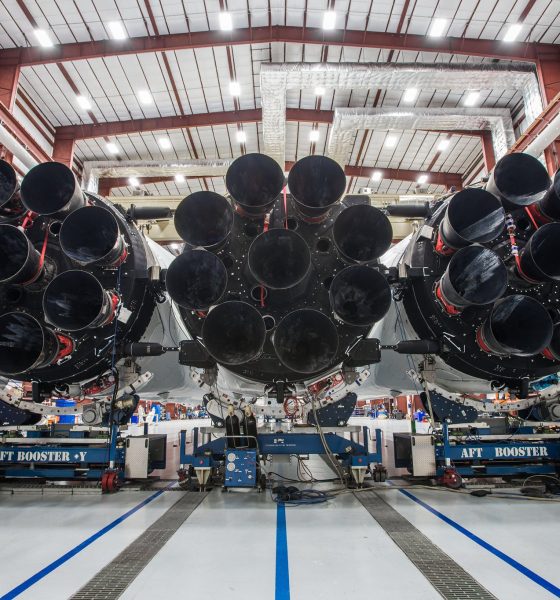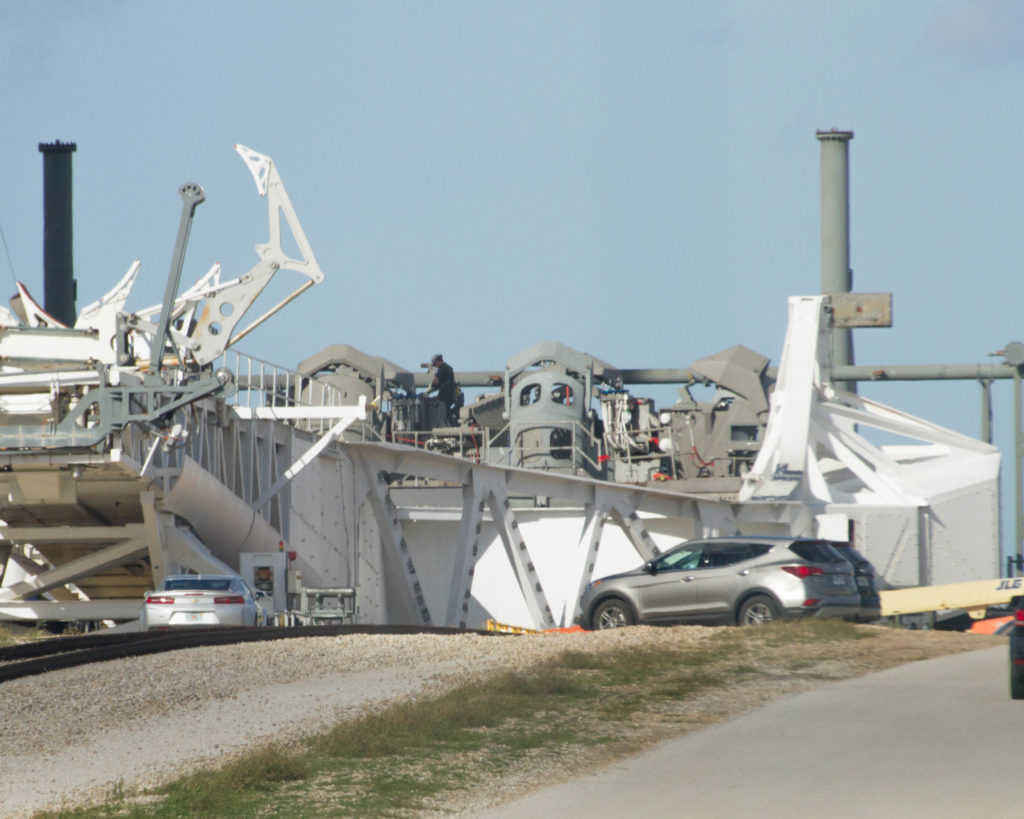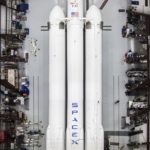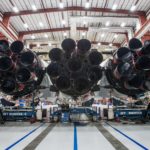

News
SpaceX’s Falcon Heavy launch imminent as Elon Musk unveils first photos
For the first time in SpaceX’s history, the company is close enough to the inaugural launch of its massive Falcon Heavy rocket that the vast majority of the vehicle is already at Cape Canaveral, FL, and all three of its first stages have been mated together.
- The first Falcon Heavy, seen here fully integrated aside from its payload fairing. (SpaceX)
- Falcon Heavy’s three boosters and 27 Merlin 1D engines on full display. (SpaceX)
We know this because Elon Musk took to Instagram and Twitter last night and posted the first-ever real-life photos of the launch vehicle, currently stationed at the Horizaontal Integration Facility (HIF) at SpaceX’s LC-39A launch pad.
At launch, Falcon Heavy will only be surpassed in thrust and payload by the megarockets of the 1960s, the US Saturn V and the Soviet N-1. Best described by an eager employee, Falcon Heavy will have the same thrust as fifteen 747 Jumbo Jets at full throttle, and could nearly carry a fully-loaded 737 passenger jet into low Earth orbit (LEO) in a fully expendable configuration.
Over the past several weeks of inactivity, SpaceX’s pad technicians have been hard at work modifying the LC-39A launch pad and its Transporter/Erector/Launcher (TEL) to support the inaugural launch of Falcon Heavy. This mainly involved considerably upgrading the water deluge system used to muzzle the impact of the sheer sound created at launch, but also required the addition of four more hold-down clamps, necessary to abort a launch after engine ignition. An additional array of communications wiring and umbilical connections for fueling have also likely been added to the TEL in order to support the requirements of what are essentially three simultaneous Falcon 9 launches.

Pad 39A’s TEL undergoing modifications. Hold-down clamps are the grey enclosures seen at the end of the TEL. Note the worker standing in the middle for a sense of scale. (Tom Cross/Teslarati)
A lack of frenetic activity at the pad in the last handful of days suggests that those modifications are nearly complete, and SpaceX fans and followers are now eagerly awaiting the rollback of the TEL to 39A’s integration facilities, where Falcon Heavy will soon after be integrated with the TEL for the first time ever. After this milestones, we can expected Falcon Heavy to be rolled out the pad for what is known as a wet dress rehearsal (WDR), akin to a launch or static fire but without any engine ignition. It’s possible that a bug-free WDR could fluidly transition into the first static fire for the vehicle, but it is probable that SpaceX will take a more cautious approach with this launch campaign. Following the successful completion of the WDR and static fire, Falcon Heavy’s inaugural launch will be imminent. We are potentially no more than 40 days out, the closest SpaceX has ever been to a Falcon Heavy launch.
Of note, the final picture posted by Musk offers an absolutely stunning view of the vehicle’s business end, showing off its 27 Merlin 1D engines and revealing quite obviously that both of Falcon Heavy’s side cores are flight-proven, whereas the center core is new. The photos provided also offer a glimpse of the only component clearly missing, the second stage and its mysterious Tesla Roadster payload. Unconfirmed whispers in the fan community have it on good authority that the Roadster has in fact already been mated to the second stage’s payload adapter, and transport to the Cape and integration with the full Falcon Heavy stack are undoubtedly imminent.
Falcon Heavy at the Cape pic.twitter.com/hizfDVsU7X
— Elon Musk (@elonmusk) December 20, 2017
Possibly most significant of all, Musk suggested that the Roadster payload would be sent on a course to Mars, although it has yet to be concluded whether that will be in the form of a general orbit similar to Mars or an actual trans-Martian injection culminating in an orbit around the Red Planet. The former is far more likely, but the latter would be an extraordinarily impressive test of SpaceX hardware in deep space, a necessary precursor for the company’s goals of interplanetary colonization. Time will tell, and in the meantime we can expect a veritable flood of rocket and payload photos as SpaceX rapidly approaches a historic moment for the company.
Be sure to follow us on Instagram as we go bring you live video and behind the scenes coverage from Cape Canaveral at each SpaceX launch!

Elon Musk
Elon Musk and Tesla AI Director share insights after empty driver seat Robotaxi rides
The executives’ unoccupied tests hint at the rapid progress of Tesla’s unsupervised Robotaxi efforts.

Tesla CEO Elon Musk and AI Director Ashok Elluswamy celebrated Christmas Eve by sharing personal experiences with Robotaxi vehicles that had no safety monitor or occupant in the driver’s seat. Musk described the system’s “perfect driving” around Austin, while Elluswamy posted video from the back seat, calling it “an amazing experience.”
The executives’ unoccupied tests hint at the rapid progress of Tesla’s unsupervised Robotaxi efforts.
Elon and Ashok’s firsthand Robotaxi insights
Prior to Musk and the Tesla AI Director’s posts, sightings of unmanned Teslas navigating public roads were widely shared on social media. One such vehicle was spotted in Austin, Texas, which Elon Musk acknowleged by stating that “Testing is underway with no occupants in the car.”
Based on his Christmas Eve post, Musk seemed to have tested an unmanned Tesla himself. “A Tesla with no safety monitor in the car and me sitting in the passenger seat took me all around Austin on Sunday with perfect driving,” Musk wrote in his post.
Elluswamy responded with a 2-minute video showing himself in the rear of an unmanned Tesla. The video featured the vehicle’s empty front seats, as well as its smooth handling through real-world traffic. He captioned his video with the words, “It’s an amazing experience!”
Towards Unsupervised operations
During an xAI Hackathon earlier this month, Elon Musk mentioned that Tesla owed be removing Safety Monitors from its Robotaxis in Austin in just three weeks. “Unsupervised is pretty much solved at this point. So there will be Tesla Robotaxis operating in Austin with no one in them. Not even anyone in the passenger seat in about three weeks,” he said. Musk echoed similar estimates at the 2025 Annual Shareholder Meeting and the Q3 2025 earnings call.
Considering the insights that were posted Musk and Elluswamy, it does appear that Tesla is working hard towards operating its Robotaxis with no safety monitors. This is quite impressive considering that the service was launched just earlier this year.
Elon Musk
Starlink passes 9 million active customers just weeks after hitting 8 million
The milestone highlights the accelerating growth of Starlink, which has now been adding over 20,000 new users per day.

SpaceX’s Starlink satellite internet service has continued its rapid global expansion, surpassing 9 million active customers just weeks after crossing the 8 million mark.
The milestone highlights the accelerating growth of Starlink, which has now been adding over 20,000 new users per day.
9 million customers
In a post on X, SpaceX stated that Starlink now serves over 9 million active users across 155 countries, territories, and markets. The company reached 8 million customers in early November, meaning it added roughly 1 million subscribers in under seven weeks, or about 21,275 new users on average per day.
“Starlink is connecting more than 9M active customers with high-speed internet across 155 countries, territories, and many other markets,” Starlink wrote in a post on its official X account. SpaceX President Gwynne Shotwell also celebrated the milestone on X. “A huge thank you to all of our customers and congrats to the Starlink team for such an incredible product,” she wrote.
That growth rate reflects both rising demand for broadband in underserved regions and Starlink’s expanding satellite constellation, which now includes more than 9,000 low-Earth-orbit satellites designed to deliver high-speed, low-latency internet worldwide.
Starlink’s momentum
Starlink’s momentum has been building up. SpaceX reported 4.6 million Starlink customers in December 2024, followed by 7 million by August 2025, and 8 million customers in November. Independent data also suggests Starlink usage is rising sharply, with Cloudflare reporting that global web traffic from Starlink users more than doubled in 2025, as noted in an Insider report.
Starlink’s momentum is increasingly tied to SpaceX’s broader financial outlook. Elon Musk has said the satellite network is “by far” the company’s largest revenue driver, and reports suggest SpaceX may be positioning itself for an initial public offering as soon as next year, with valuations estimated as high as $1.5 trillion. Musk has also suggested in the past that Starlink could have its own IPO in the future.
News
NVIDIA Director of Robotics: Tesla FSD v14 is the first AI to pass the “Physical Turing Test”
After testing FSD v14, Fan stated that his experience with FSD felt magical at first, but it soon started to feel like a routine.

NVIDIA Director of Robotics Jim Fan has praised Tesla’s Full Self-Driving (Supervised) v14 as the first AI to pass what he described as a “Physical Turing Test.”
After testing FSD v14, Fan stated that his experience with FSD felt magical at first, but it soon started to feel like a routine. And just like smartphones today, removing it now would “actively hurt.”
Jim Fan’s hands-on FSD v14 impressions
Fan, a leading researcher in embodied AI who is currently solving Physical AI at NVIDIA and spearheading the company’s Project GR00T initiative, noted that he actually was late to the Tesla game. He was, however, one of the first to try out FSD v14.
“I was very late to own a Tesla but among the earliest to try out FSD v14. It’s perhaps the first time I experience an AI that passes the Physical Turing Test: after a long day at work, you press a button, lay back, and couldn’t tell if a neural net or a human drove you home,” Fan wrote in a post on X.
Fan added: “Despite knowing exactly how robot learning works, I still find it magical watching the steering wheel turn by itself. First it feels surreal, next it becomes routine. Then, like the smartphone, taking it away actively hurts. This is how humanity gets rewired and glued to god-like technologies.”
The Physical Turing Test
The original Turing Test was conceived by Alan Turing in 1950, and it was aimed at determining if a machine could exhibit behavior that is equivalent to or indistinguishable from a human. By focusing on text-based conversations, the original Turing Test set a high bar for natural language processing and machine learning.
This test has been passed by today’s large language models. However, the capability to converse in a humanlike manner is a completely different challenge from performing real-world problem-solving or physical interactions. Thus, Fan introduced the Physical Turing Test, which challenges AI systems to demonstrate intelligence through physical actions.
Based on Fan’s comments, Tesla has demonstrated these intelligent physical actions with FSD v14. Elon Musk agreed with the NVIDIA executive, stating in a post on X that with FSD v14, “you can sense the sentience maturing.” Musk also praised Tesla AI, calling it the best “real-world AI” today.










